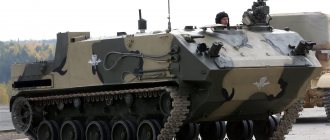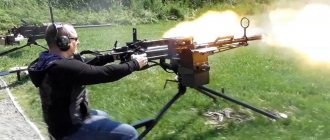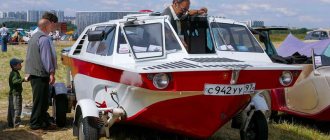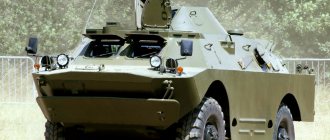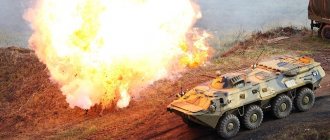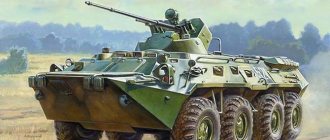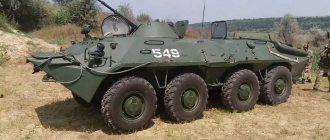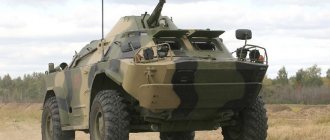01-Rakushka_zr-09_15
Shells debut at the Victory Parade.
The rubber inserts in the track tracks for driving on asphalt and paving stones are clearly visible. Shells debut at the Victory Parade. The rubber inserts in the track tracks for driving on asphalt and paving stones are clearly visible.
Shells debut at the Victory Parade. The rubber inserts in the track tracks for driving on asphalt and paving stones are clearly visible.
History of the creation of an armored personnel carrier
At the end of the 60s, after the adoption of the very successful BMP-1, the need for a serious modernization of the BTR-60 armored personnel carrier or replacing it with a new vehicle with a more powerful engine and weapons became obvious. The military generally had the idea of abandoning armored personnel carriers and transferring infantry to infantry fighting vehicles. As a result, they decided to do something in between a wheeled armored personnel carrier and an infantry fighting vehicle.
The BTR-60 was equipped with a turret from the BMP-1 with a smoothbore cannon and a PKT machine gun. The prototype received the designation BMP GAZ-60, but it was never put into mass production. Because due to the increased weight, the new car had extremely unsatisfactory speed and maneuverability. However, the gained developments were not wasted; it was on the basis of the GAZ-60 BMP that the BTR-70 was created.
The designers installed two ZMZ-4905 gasoline engines on the armored personnel carrier, each of which had a power of 120 hp. With. This made it possible to achieve high power density and, as a result, good speed characteristics of the new armored personnel carrier. As the main armament of the BTR-70, the designers proposed a KPVT machine gun mounted in a rotating turret.
Compared to the BTR-60, the new armored personnel carrier had a lower hull height (by 185 mm), which somewhat reduced the likelihood of being hit by enemy fire.
In general, the new vehicle was for the military, which is why it was put into service in 1972. Since the late 70s, under Soviet license, the production of the BTR-70 has been established in Romania. Until the end of the 90s, the Romanians produced 154 cars.
Operating experience of the BTR-70 showed a number of shortcomings that caused the serial production of this armored personnel carrier to stop. The biggest problem was the great difficulty of repairing and maintaining the transmission and power plant, which consists of two engines. In this respect, the BTR-70 was very similar to its predecessor, the BTR-60 armored personnel carrier. The design of the machine's water-jet propulsion system, which tends to become clogged with algae, mud and silt, cannot be called successful either.
02-Rakushka_zr-09_15
Hatch in the aft part of the wheelhouse for landing troops.
Swimming vests for soldiers and crew are attached to it. Hatch in the aft part of the wheelhouse for landing troops. Swimming vests for soldiers and crew are attached to it.
Hatch in the aft part of the wheelhouse for landing troops. Swimming vests for soldiers and crew are attached to it.
COMFORTABLE TO THE FRONT
The conveyor body is welded, the so-called chopping type. Consists of a control compartment, a troop compartment and a motor-transmission compartment. Bulletproof armor.
Checking the accuracy and accuracy of machine gun combat
Before carrying out work, make a sighting target, which is drawn on a sheet of light thick paper (cardboard) measuring 1x1 m (Fig. 28).
Rice. 28. Sighting target (dimensions in mm).
The work is carried out with ammunition from the same batch with the B-32 bullet for the KPVT machine gun and with a bullet with a steel core for the PKT machine gun.
Equip ammunition as follows:
— one belt with 5 cartridges and three or four belts of 10 cartridges each for KPVT;
-one belt with 5 cartridges and three or four belts of 10 cartridges each for PKT;
Work order:
— carry out work in terms of preparing the vehicle, turret installation, machine guns and sight for work;
— at a distance of 100 m from the end of the KPVT flame arrester, install a shield with a target attached to it so that the plumb line on the target is parallel to the vertical line in the sight, and the o on the target is close to the crosshair in the sight;
— prepare machine guns for firing by loading them with belts with 5 cartridges;
— point the machine guns past the target and fire bursts of five sedimentary shots: first from the KPVT, then from the PKT;
— load machine guns with 10-round belts;
— set the horizontal line in the field of view of the sight to the zero mark of the range scales;
— place the crosshairs of the sight on the target and smoothly, without jerking, brake the brakes of the shoulder strap and the lifting mechanism. Make sure that the crosshairs of the sight coincide with those on the target;
— fire a continuous burst of 10 shots from the KPVT;
— determine the average point of impact of the first stage (see Fig. 1)
Determine the accuracy of the first stage combat by drawing a circle with a radius of 350 mm with the center at the STP. Within this circle there must be at least 8 holes, i.e. combat accuracy) must be at least 80%.
The accuracy of the fire is considered unsatisfactory, and the survivability of the barrel is exhausted if the dispersion radius exceeds 875 mm. The barrel needs to be replaced.
Inspect the holes in the target. If more than 5 holes have an oval shape, then the survivability of the barrel is also exhausted. This barrel must be replaced.
If the results of checking the accuracy of the combat are positive, continue checking the accuracy of the KPVT combat in the first place, for which:
— mark on the target any holes in it;
— load the KPVT with a second belt with 10 rounds and repeat aimed shooting at the target;
— determine the STP of the second stage;
— mark on the target any holes in it;
— load the KPVT with a third belt with 10 rounds and perform aimed shooting at the target for the third time;
— determine the STP of the third stage;
determine the STP of three queues - the actual STP (Fig. 29)
Rice. 29. Determination of the STP of hitting three bursts.
KPVT combat accuracy is considered satisfactory if STP. the actual one is within a circle with a radius of no more than 135 mm (Fig. 28).
If the actual STP is located outside this circle or on its border, adjust the alignment of the sight relative to the actual line of fire of the KPVT, using the reticle moving mechanisms.
The magnitude of the amendments is determined:
— horizontally — on the lateral correction scale (one small division 0-02);
- vertically - according to the height of the strokes of the lateral correction scale (the height of the small stroke is 0-04, the large stroke is 0-06).
After receiving positive results of checking the accuracy and accuracy of the KPVT combat, check the accuracy and accuracy of the PCT combat, for which:
— place the crosshairs of the sight on the target, and smoothly, without jerking, brake the brakes of the shoulder strap and the lifting mechanism. Make sure that the crosshairs of the sight coincide with those on the target;
— fire a continuous burst of 10 shots from the PKT;
— determine the first stage STP.
Determine the accuracy of the first stage combat by drawing a circle with a radius of 180 mm with the center at the STP. Within this circle there must be at least 8 holes, i.e. the accuracy of the battle should be at least 80%.
The accuracy of the fire is considered unsatisfactory and the survivability of the barrel is exhausted if the dispersion radius exceeds 450 mm. If the accuracy of the battle is unsatisfactory, replace the machine gun.
After replacing the machine gun, repeat the work.
If the results of checking the accuracy of the combat are positive, in the first place, continue work on checking the accuracy of the PKT combat, for which:
- mark the holes on the target;
— load the PKT with a second belt with 10 rounds and repeat aimed shooting at the target;
— determine the STP of the second stage; mark the holes in the target on the target;
— load the PKT with a third belt with 10 rounds and perform aimed shooting at the target for the third time;
— determine the STP of the third stage;
- determine the STP of three queues - the actual STP (see Fig. 29).
The accuracy of the PKT combat is considered satisfactory if the actual SPP is within a circle with a radius of no more than 60 mm (Fig. 28).
If the actual STP is located outside the circle with a radius of 60 mm or within it, but on its border, adjust the position of the PCT, for which:
— determine the actual values (in mm) of the deviation of the STP from the actual center of the PCT mark on the target, both vertically and horizontally;
— count the number of notches by which it is necessary to turn the adjusting bushings of the alignment mechanism of the base of the PKT carriage in order to “bring” the actual STP to the center of the PKT mark on the sighting target.
When calculating, assume that to move the STP by 100 mm (both vertically and horizontally), the bushings must be rotated by one notch. The marks are marked on the surface of the bushing collar;
— unscrew the adjusting bushings, tighten them by the required number of notches and tighten;
— repeat the work to check the accuracy of the PKT engagement on the sighting target.
After positive results, tighten the adjusting bushings. If, when checking the accuracy and accuracy of the fire, work was carried out to adjust the position of the sight and (or) PKT relative to the KPVT, be sure to draw up a new control and alignment target.
03-Rakushka_zr-09_15
RPM, speed, distance traveled, engine hours are displayed on a color monitor.
Other readings can also be displayed. The driver's position is in the center of the car. The commander is on the left, the paratrooper and part-time machine gun shooter is on the right. Semi-automatic gearbox lever and control wheel. The black button in the center of the hub turns on the rotating mode. RPM, speed, distance traveled, engine hours are displayed on a color monitor. Other readings can also be displayed. The driver's position is in the center of the car. The commander is on the left, the paratrooper and part-time machine gun shooter is on the right. Semi-automatic gearbox lever and control wheel. The black button in the center of the hub turns on the rotating mode.
RPM, speed, distance traveled, engine hours are displayed on a color monitor. Other readings can also be displayed. The driver's position is in the center of the car. The commander is on the left, the paratrooper and part-time machine gun shooter is on the right. Semi-automatic gearbox lever and control wheel. The black button in the center of the hub turns on the rotating mode.
The commander has the least space. His seat is surrounded by instruments and optics, and the hatch is perhaps the narrowest. It’s not surprising: nearby on the roof are mounting elements for a remote-controlled all-round machine gun, sighting and instrument systems, and an illuminator. Another machine gun, a course one, is installed in the front part on the right, in front of the paratrooper’s seat. It's also quite comfortable here.
The driver's workplace is similar to that in the BMD-4M. Instead of a rudder there is a steering wheel. Nearby is the lever of a four-speed semi-automatic transmission. There are two pedals: gas and brake. It is easy to lift the chair up to operate the car by sticking your head into the open hatch.
In a combat situation (with the hatch closed), they are guided by three periscope observation devices, and the central one, if necessary, is replaced by a night vision device. There are no analog devices in Rakushka. The driver has a huge display of the digital information and control system at his disposal. All parameters - temperature, pressure, voltage, revolutions, speed, etc. - are displayed on a color LCD screen.
Armored personnel carrier BTR-80
Armored personnel carrier BTR-80
A wheeled four-axle armored personnel carrier developed on the basis of the BTR-70, taking into account the experience of using these vehicles in Afghanistan. Adopted into service in 1986. Serial production at AMZ since 1986.
SERIAL MODIFICATIONS: BTR-80 (GAZ-5903) – the general layout is similar to the BTR-70. The frontal and side plates of the hull have seven hatches with ball joints for firing personal weapons. There are two double-leaf doors on the sides of the vehicle, and four hatches in the roof of the hull, two of them above the troop compartment. The armored personnel carrier is equipped with a BPU-1 turret machine gun mount, on which smoke grenade launchers of the 902V “Tucha” system are placed. The power plant consists of one KamAZ-7403 diesel engine. Since 1993, the YaMZ-238M2 diesel engine with a power of 240 hp has been installed on the armored personnel carrier. Bullet-resistant tires KI-80 or KI-126. Early production vehicles had the R-123M radio station.
BTR-80A (GAZ-59029, 1994) is a turret-mounted cannon-machine gun mount designed to combat ground and low-flying air targets, which houses a 30-mm 2A72 automatic cannon and a coaxial PKT machine gun. Vertical pointing angles from -5° to +70°. Ammunition capacity: 300 shells and 2000 rounds. Day sight 1PZ-9 and night sight TPN-3-42 “Crystal”. Combat weight 14.5 tons.
BTR-80S (1994) - version of the BTR-80A for internal troops. Instead of a 30-mm cannon, a KPVT heavy machine gun is installed. BTR-80K is an armored personnel carrier designed for the commander of a motorized rifle battalion. Three workplaces are equipped for officers to work. The vehicle is equipped with two R-163-50U radio stations, an 11th telescopic mast, and TNA-4-6 navigation equipment with an indicator tablet. Two remote VHF radio stations R-159.
BTR-80KSh (GAZ-59032) is a command and staff vehicle based on the BTR-80.
BMM-80 (GAZ-59039) – armored medical vehicle. In addition to the crew, it is possible to transport 7 wounded in the medical department and 2 on the roof on stretchers. Depending on the composition of the medical and sanitary equipment, the BMM can be used for the evacuation of the wounded from the battlefield (BMM-1), as a battalion first aid station (BMM-2) and a mobile dressing station with a medical team and an automatic dressing station AP-2 (BMM-3) .
BTR-80 armored personnel carriers began to enter service with motorized rifle units of the Soviet Army, Navy Marines, border and internal troops in the late 80s. They were used by Soviet troops in Afghanistan. In addition to the listed modifications, on the basis of the BTR-80, a radiation and chemical reconnaissance vehicle RKhM-4, an artillery control vehicle 1V118, a mobile command and observation post of the PKNP “Kushetka-B”, a satellite communication station, a sound broadcasting station, and an armored repair and recovery vehicle BREM- were created. K and self-propelled artillery gun 2S23 “Nona-SVK”.
BTR-80s are in service in almost all CIS countries, as well as in Estonia (20 units), Hungary (245), Turkey (100) and Sierra Leone. BTR-80 armored personnel carriers of various modifications were used by the Russian Army in Chechnya and Tajikistan, as well as by Russian contingents of the UN forces in Bosnia and Kosovo.
TACTICAL AND TECHNICAL CHARACTERISTICS OF BTR-80
COMBAT WEIGHT, t: 13.6. CREW, people: 2. LANDING MAN, people: 8. OVERALL DIMENSIONS, mm: length – 7650, width – 2900, height – 2350, wheelbase – 4400, track – 2410, ground clearance – 475. ARMAMENT: 1 KPVT machine gun of 14.5 mm caliber, 1 PKT machine gun of 7.62 mm caliber, 6 launchers for 81 mm smoke grenades. AMMUNITION; 500 rounds of 14.5 mm caliber, 2000 rounds of 7.62 mm caliber. AIMING DEVICES: sight 1PZ-2. ARMOR, mm: hull front-10, side-7...9, stern-7, turret-7. ENGINE: KamAZ-7403, 8-cylinder, diesel, four-stroke, V-shaped, turbocharged, liquid cooled; power 260 hp at 2600 rpm, displacement 10,850 cm3. TRANSMISSION: dry double-disc clutch, five-speed gearbox with synchronizers in 2nd, 3rd, 4th and 5th gears, cardan transmission, two-stage transfer case with differential torque distribution in two streams (in 1st - 3 1st and 2nd - 4th axles) and a differential lock, a power take-off box for a water-jet propulsion unit and a winch, four main gears, four differentials, and eight wheel gearboxes are mounted on the transfer case. CHASSIS: wheel formula 8x8, tire size 13.00-18″, air pressure in tires is adjustable from 0.5 to 3 kg/cm2, independent torsion bar suspension, hydraulic shock absorbers, telescopic, double acting, two each at wheels 1 -th and 4th axles and one each for the wheels of the 2nd and 3rd axles, the wheels of the 1st and 2nd axles are steerable. MAX. SPEED, km/h: on land – 80, afloat – 9. COURSE RESERVE: on land – 600 km, afloat – 12 hours. OBSTACLES TO OVERCOME: ascent angle, degrees. - thirty; ditch width, m – 2; wall height, m – 0.5. COMMUNICATIONS: radio station R-163-50U and intercom R-174.
06-Rakushka_zr-09_15
The troop compartment can accommodate 13 soldiers or 2 tons of cargo.
For a Spartan armored vehicle interior, it is quite spacious. The troop compartment can accommodate 13 soldiers or 2 tons of cargo. For a Spartan armored vehicle interior, it is quite spacious.
The troop compartment can accommodate 13 soldiers or 2 tons of cargo. For a Spartan armored vehicle interior, it is quite spacious.
general information
In the early 70s of the last century, there was a need to improve the BTR-60. Initially, engineers wanted to install a turret with a BMP-1 on the chassis of the 60th model to transport paratroopers. This is how the GAZ-50 BMP appeared, but the project did not develop beyond the prototype stage. On its basis, the BTR-70 armored personnel carrier was developed. Cross-country ability was improved due to the installation of more powerful power plants.
The technique performs several tasks. First, it delivers infantry detachments to the battlefield, and then provides fire support to the soldiers. For this purpose, two machine guns are used, which are included in the armament of the BTR-70. Transport has gone through a huge number of military operations in the 20th and 21st centuries. It is now in service in more than 20 countries.
The Soviet leadership adopted the car for service in 1971, and mass production was launched in 1976. Initially, the 70th armored personnel carrier was assembled at the Gorky Automobile Plant. Since 1986, production has been concentrated at the Arzamas enterprise.
Modifications
Based on the standard version, designers in different countries made the following varieties:
- KShM - modification is used as a command and control point of movement;
- MS is a technique used for communication. The usual tower was abolished, it was replaced by additional radio stations;
- BTR 70M is an improved version of the classic version. Two engines were replaced with a diesel KamAZ-7403, which develops up to 260 horsepower. The transmission was installed from the BTR-80;
- TAV-77 - 70th model of Romanian production;
- “Thunder” is the development of Ukrainian specialists from the Kharkov Design Bureau. The standard power unit was replaced by a diesel UTD-20. The turret was replaced by the Thunder combat kit, consisting of an automatic cannon, a machine gun and an automatic grenade launcher;
- KBA-2 is a product of the Kharkov Design Bureau. A UTD-20 motor was installed. The KPVT was replaced with a 30-mm KBA-2 gun;
- T - modification of Ukrainian. Many elements were adopted from the 80th model (taillights, side hatches, etc.). Gasoline engines were replaced with diesel engines, developing up to 312 horsepower in total;
- BTR-7 is a deep reworking of the original version. Created by Ukrainian engineers. All that remains of the original vehicle is the body and a few technical components. The design is made up of Ukrainian and European modern technologies;
- BTR 70M-A1 - modification of Belarusian production. GAZ-49B was replaced with diesel power units (136 horsepower each). It is possible to replace the standard turret with a BM-30 module. Air conditioning is installed inside the cabin to increase comfort;
- The BTR 70M B1 is a Belarusian version developed by the 140th Repair Plant organization. Many technical solutions were carried over from the 80th model. Two engines were replaced with a diesel engine (260 horsepower);
- Cobra-K is a joint development of Russian, Belarusian and Slovak specialists. Distinctive features: improved weapons module “Cobra”, smoke system “Tucha” and air conditioners made in Germany;
- The BTR 70M is an Azerbaijani product, in the development of which Russian and South African engineers also took part. Standard armor has been improved, the turret has been replaced by the Shimshek combat module;
- BTR 70M D - Kazakh version. Powered by a D-235.9E2 engine, which develops up to 270 horsepower. The device is supplemented with Turkish thermal imagers.
The popularity of the 70th armored personnel carrier is proven by numerous modifications, which are being developed in many countries around the world.
